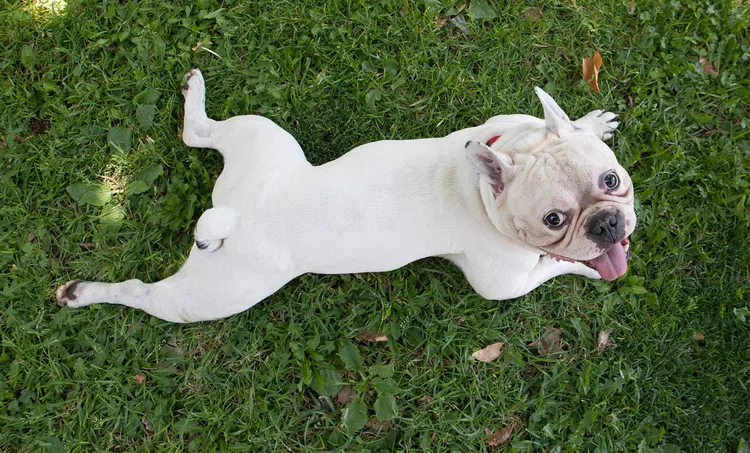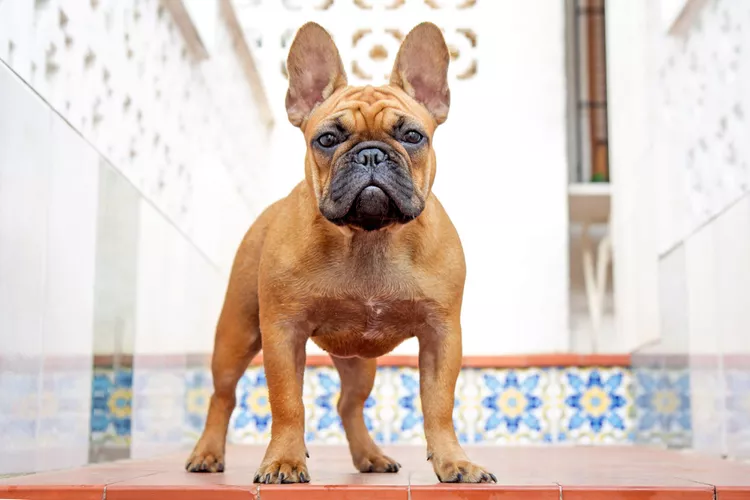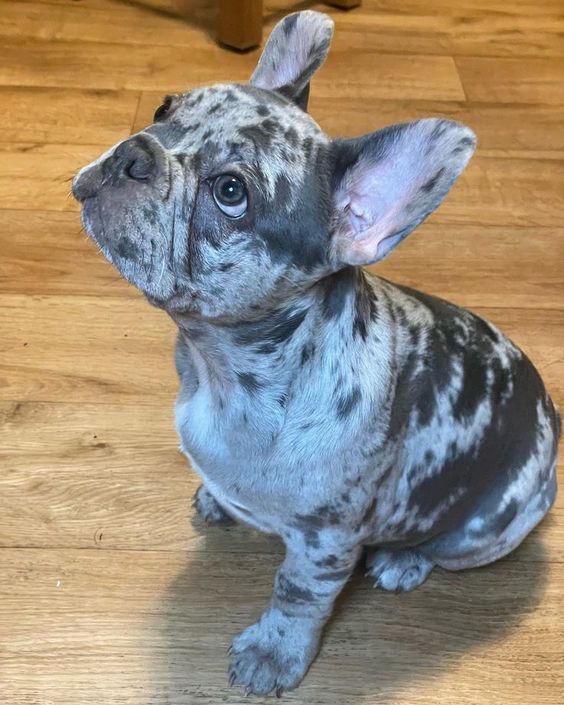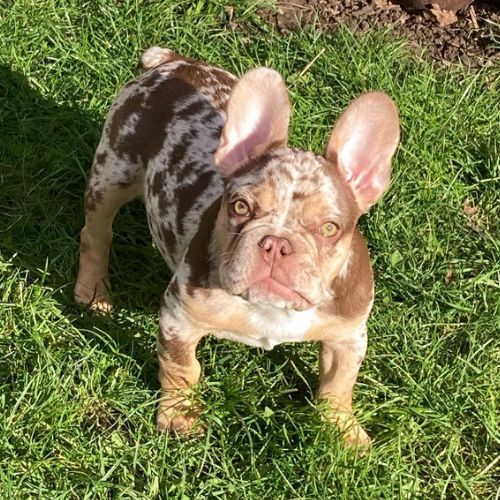French Bulldog Dog Breed Information
Regarding French bulldog dog breed information, the French Bulldog is known for its bat-like ears and muscular build, a small breed that has won hearts worldwide. The French Bulldog, also known as a Frenchie, traces its roots back to 19th-century England and later became popular in France. Charms people with their friendly personality and distinctive looks.
With a smooth coat that can be brindle or fawn and a short, flat face, the French bulldog breed is known for its expressive eyes and snub nose. These Frenchies fit well into different living spaces, from city apartments to homes with yards, as they don’t need much exercise. They do, however, have some health issues to watch for, like panting excessively and snoring due to breathing issues and back problems.
If you’re looking for a devoted and interactive pet, the French Bulldog breed is a popular option.
Key Takeaways
- French Bulldogs charm with distinct ears and friendly nature.
- The French Bulldog breed, adaptable to various homes, requires minimal exercise.
- Be mindful of the breed information detailing their potential health concerns, including respiratory issues and tendency to snore excessively.
Quick Facts
According to the American Kennel Club, the French Bulldog is the top dog breed. These robust little dogs, easily recognized by their distinctive bat-like ears, typically live 10-12 years. They’re perfect for city living due to their adaptable nature. The breed information highlights they grow to a height of 11-13 inches and weigh less than 28 pounds.
Although they’re a beloved breed, French Bulldogs face some health challenges related to their compact skull, known as brachycephalic syndrome, which can cause them to pant and snore excessively. Frenchies ‘ owners of Frenchies should be proactive in managing their health with regular vet visits and a proper diet to prevent issues like hip dysplasia and promote overall health.
French Bulldog Pictures






Overview
The French Bulldog breed is a small and robust type known for their loving nature and adaptability to various living environments. Breed information on Frenchies typically has them standing about 11-13 inches in height and weighing no more than 28 pounds, with a life span of 10-12 years.
These French Bulldog breed dogs are playful and vigilant, making them a favored choice for city dwellers. Frenchies are easily recognized by their distinctive features: oversized bat-like ears, expressive eyes, and notable flat noses. They also tend to snore due to this build.
The French Bulldog Club of America advocates for responsible pet ownership and ethical breeding to ensure the health and happiness of these dogs. People considering a French Bulldog should be informed about the breed’s specific health issues, such as brachycephalic syndrome and knee problems like patellar luxation.
Owners must provide appropriate care, regular exercise, and grooming to help these dogs live healthy lives.
Key Breed Insights
Before bringing a French Bulldog into your home, learning about their health needs and personality traits is wise. These loveable dogs have a distinctive short snout, making them susceptible to breathing issues, so monitoring their respiratory health is essential. They’re known for their upright ears, which add to their charm, but they also need regular checks to avoid infections.
Here’s a quick guide to essential French Bulldog characteristics:
| Trait | Description | Consideration |
|---|---|---|
| Lifespan | 10-12 years | Schedule consistent vet visits. |
| Group | Non-Sporting | It’s a good match for many homes. |
| Temperament | Playful, alert | Interactive toys can keep them engaged. |
| Maintenance | Low | Easy-care coat and moderate activity needs. |
| Adaptability | High | Well-suited for urban living. Companion Dog. |
This snapshot provides a clear idea of what to expect for anyone considering a French Bulldog as a new family member. It’s important to remember that understanding these aspects is critical to keeping your pet healthy and content.
Breed Origin and Evolution

The French Bulldog stands out with its signature looks and friendly nature due to careful breeding practices. Its journey began in the 1800s when English Bulldogs were mixed with smaller local dogs in France, creating the breed we adore today. The species has undergone significant changes, which are evident when looking at its history and how its features have adapted over time.
- Historical Bulldog Background
- Origin from English Bulldogs in France
- Mixing with Parisian ratters
- Recognition Achievements
- American Kennel Club’s acknowledgment in 1898
- Popularity boost in the U.S. during the 20th century
- Trait Evolution
- Development of distinct bat-like ears
- Breeding for a compact, friendly size
- Changes that led to the pronounced flat face
The French Bulldog’s ancestry can be traced back to English Bulldogs brought to France and crossbred with local dogs. This mix aimed to create a lap-sized bulldog suited for city living. Gaining official status from the French Bull dog club and American Kennel Club in 1898 marked a key milestone for the breed, with its popularity soaring in the following century.
Distinct traits like the breed’s unique bat-like ears were cultivated over time. Bulldog breeders preferred a smaller size for city dwellings, and over generations, this led to the French Bulldog’s recognizable flat face. These changes show the breed’s transformation from a working-class ratter to a beloved companion.
Historical Bulldog Ancestry
French Bulldogs carry a fascinating history that traces back to British bulldogs. These toy bulldogs were once popular among English lace workers.
With the Industrial Revolution changing jobs, many workers moved to France, bringing their dogs along. There, these dogs adapted and were selectively bred, which, along with mixing with other local breeds, led to the distinct characteristics of the Bouledogue Francais.
Their charming looks and demeanor quickly won the hearts of many, making them favored pets across households.
Modern Recognition Milestones
Breed standards for the French Bulldog were set in the late 19th century, a significant step in acknowledging the breed’s unique qualities. Its charm won over France and later captured the hearts of Americans, propelling it to become a trendy pet among the elite and a respected participant in dog shows.
By 1906, the breed had become incredibly sought after in the U.S., ranking as the fifth most popular dog. The American Kennel Club, a respected organization for dog pedigrees, recognized the French Bulldog, reflecting its growing status.
High-profile events like the Westminster Kennel Club Dog Show have also showcased the breed’s appeal and signature look, solidifying its reputation as a cherished and well-known member of the dog community.
Evolutionary Trait Changes
Selective breeding has dramatically transformed the French Bulldog’s appearance, focusing on unique features like bat-like ears and compact physique. These dogs, a mix of local breeds and Bulldogs, now show pronounced features typical of brachycephalic species, such as a flat face and a broad head. The breed’s characteristic bat ears, once just a variation, have been intentionally bred to become the norm.
While these traits are visually appealing and have made the breed quite popular, they have a downside. French Bulldogs don’t are prone to breathing issues, specifically brachycephalic airway obstructive syndrome, which is a direct result of their physical evolution. This situation shows how breeding for particular looks can harm dogs’ health.
Physical Dimensions

The physical dimensions of the French Bulldog play a critical role in their overall well-being and adaptability to different home settings.
Being a smaller breed, they have certain traits that owners should keep in mind, especially when considering the breed’s typical characteristics and health requirements.
Adult male French Bulldogs usually weigh between 20 and 28 pounds, while females are often lighter, with an average weight range of 16 to 24 pounds. They are not tall, generally measuring 11 to 13 inches at the shoulder.
Thanks to their broad, square heads, these dogs have a strong, muscular form, shiny coats, and sturdy looks. Their short legs underpin a rounded body, giving them a distinctive and powerful presence.
Breed Average Weight
An adult French Bulldog typically weighs less than 28 pounds, which is perfect for those seeking a small dog. These sturdy dogs have a muscular build and a short stature, usually measuring 11-13 inches at the shoulder.
Their signature look includes a square head, vast body, and wrinkled skin that fits their size without appearing oversized.
Due to their compact size, they’re great for living in small spaces like apartments. However, their short muzzle means owners must be vigilant about their weight to avoid respiratory problems like brachycephalic obstructive airway syndrome (BOAS).
Typical Height Range
French Bulldogs stand proudly, typically 11 to 13 inches at the shoulder. Their size places them in the small dog category, but don’t let that fool you; they have a robust build.
Despite their shorter stature, these dogs make a strong impression with a broad body, dense bones, and well-developed muscles. These features give French Bulldogs a low center of gravity, making their movements steady and robust.
Their head is strikingly square and topped with large ears that stand erect, adding to their unique look. The wrinkles on their face, formed by soft, loose skin, are a charming characteristic of the breed but don’t affect their overall height.
Body Shape Characteristics
French Bulldogs are known for their remarkable height, muscular build, and sturdy physique. Their wide stance and dense bone structure highlight their strength and provide a solid base. These dogs have a low center of gravity that gives them outstanding balance, and their broad frame adds to their robust appearance.
The breed’s distinct large, square heads and upright bat ears give them an attentive and curious look. The wrinkles on their soft skin, along with their unique ears, make French Bulldogs instantly recognizable.
Owners should know that their physical traits can lead to health issues, including breathing problems due to short snouts. Potential owners must consider these health aspects to care for their pets properly.
Growth Chart Milestones
French Bulldogs go through several growth stages from puppies until they reach full size. Monitoring their weight and height is critical for their well-being. These dogs are widely recognized for their sturdy, muscular frames and should ideally weigh under 28 pounds to keep their distinct build. They usually grow to a height of 11 to 13 inches at the shoulder.
Keeping an eye on these measurements is essential because any significant changes might signal health problems or issues with diet. Consistent vet visits are necessary to follow their growth and promptly address concerns.
The breed’s unique features, such as their broad build, strong bones, and square head, mean they need special care, like regular cleaning of their facial folds to prevent skin issues.
Size Comparison Chart
Understanding their size is critical for those considering a French Bulldog as a pet, especially if you live in an apartment or a smaller home.
These charming dogs stand about 11-13 inches tall, noticeably shorter than the typical English Bulldog’s 15-16 inches height.
Regarding weight, French Bulldogs are lighter and easier to handle, usually weighing less than 28 pounds, making them a manageable size for many living situations.
This contrast in size highlights the French Bulldog’s adaptability to more compact living spaces and their unique place among the Bulldog family.
Temperament Traits

Understanding the temperament of a French Bulldog is vital for anyone considering this breed as a pet. These dogs are known for their joyful and loving nature, perfect for families seeking a playful and cuddly companion.
However, training a French Bulldog can be a bit of a challenge due to their strong-willed personality. To succeed, owners should use consistent and positive training methods.
Regarding social skills, French Bulldogs can be excellent with kids and other animals, especially if socialized early on. They also have an alert presence, contributing to their ability to act as good watchdogs.
Consistency, love, and patience will help these dogs thrive in their homes and with their human families.
Playful, Affectionate Nature
French Bulldogs are known for their playful and affectionate nature, making them beloved by people of all ages. They fit perfectly into family life, often becoming the source of laughter and fun with their energetic behavior and love for games like fetch.
Despite their occasional stubborn streak, French Bulldogs aim to please and have a friendly attitude that’s both endearing and comforting. They get along well with new dogs and people, showing an adaptable and pleasant personality for various social situations.
Stubbornness Training Challenges
Training French Bulldogs can be tricky due to their stubborn nature despite their friendly appearance. They have a reputation for being easygoing, but their independent streak means trainers need to be more creative in their methods.
Positive reinforcement is effective in teaching these dogs, as it encourages cooperation. These dogs are great for families because of their playful and loving personalities, but it takes patience and consistency to manage their sometimes stubborn behavior.
To keep them engaged, it’s helpful to use fun training methods that appeal to their intelligence and desire to please. Knowing how to work with their personality is the secret to making progress in training a French Bulldog, even when they seem resistant.
Good With Children
French Bulldogs often become beloved members of families with kids, thanks to their loving and patient nature. They are known for their playful spirit, which pairs well with children’s lively energy. These dogs are comedians, always ready with antics that can keep kids laughing and engaged.
They’re also friendly around new faces, which means they’re usually good when your child has friends over. While they can be stubborn, French Bulldogs aim to please, making it easier to form strong connections with their young human companions. Their ability to adapt to different situations makes them reliable family pets.
Socialization With Pets
French Bulldogs are great with kids and get along well with other animals. They’re friendly and quickly adapt to new pets and people, making them excellent family dogs.
Known for their playful and amusing behavior, French Bulldogs, including other pets, keep everyone entertained. They are calm and patient, which helps them live peacefully with various breeds, contributing to a stress-free home.
Their energy levels are balanced, ensuring they can share spaces and meals with other pets without issues.
Alert, Watchful Demeanor
French Bulldogs are alert and playful, making them fantastic companions. Their bat-like ears aren’t just for looks; they help these dogs pick up on sounds, making them excellent at keeping watch.
Despite their silly antics, don’t overlook a French Bulldog’s ability to stay focused. They are also known for being loving and patient, making them even more attentive to people.
French Bulldogs strive to make their owners happy, showing their watchful side during human interactions.
Common Health Concerns

If you’re thinking about getting a French Bulldog, it’s essential to know about the health issues they might face due to their unique physical traits. Their charming appearance has a downside, making them prone to certain conditions that need attention and care.
One significant concern is brachycephalic syndrome, a condition related to short noses and flat faces, which can lead to breathing difficulties, problems with overheating, and airway obstructions. These dogs require a relaxed environment and may need medical assistance to manage their breathing.
Another common issue is hip dysplasia, a joint problem that can cause pain, difficulty walking, and eventually arthritis. Watching their weight and providing joint supplements can help manage this condition.
Lastly, French Bulldogs often deal with skin fold dermatitis. The moisture trapped in their skin folds can cause inflammation and infections. Regular cleaning of these areas is essential to prevent health problems.
Understanding these concerns is vital for any potential French Bulldog owner, as it ensures you can provide the best care for your pet. Remember to consult with a vet for specific advice and treatment options.
Brachycephalic Syndrome Risks
Brachycephalic syndrome is a severe health issue common in French Bulldogs due to their unique flat-faced shape, which restricts their breathing. The condition includes several physical problems like narrow nostrils, an overly long soft palate, and a small trachea, which make breathing difficult and can lead to dangerous situations.
Narrow nostrils, known as stenotic nares, make it hard for the dog to breathe and often require surgery to fix. These breathing problems can also lead to more health issues, such as inflamed laryngeal saccules and ongoing inflammation in the respiratory tract.
Dog owners should be careful to keep their pets at a healthy weight and avoid stressful environments to help manage the breathing difficulties associated with this syndrome.
Hip Dysplasia Prevalence
Hip dysplasia is also common in French Bulldogs, alongside brachycephalic syndrome. It’s a condition where the hip joint doesn’t fit properly, causing pain and difficulties with movement.
The issue arises when the top part of the thigh bone doesn’t fit tightly into the hip socket, leading to the joint becoming loose and worn down over time.
Despite their laid-back nature and less intense exercise needs, French Bulldogs need to stay at a healthy weight to reduce the risk of developing hip dysplasia. Regular, low-impact exercise and a well-balanced diet are essential.
It’s also essential to have your dog checked regularly by a vet to catch any signs of hip dysplasia early, which helps manage the condition and maintain your dog’s quality of life.
Skin Fold Dermatitis
French Bulldogs often suffer from skin fold dermatitis, a problem made worse by their deep facial wrinkles. These wrinkles trap moisture and warmth, creating a perfect environment for bacteria and yeast to flourish.
Owners must thoroughly clean and dry their dog’s wrinkles to prevent dermatitis and avoid issues like ear infections. Veterinarians suggest using special cleansers to protect the skin’s barrier while eliminating harmful microbes.
Consistent care is essential to keep French Bulldogs healthy and prevent skin conditions such as dermatitis.
Grooming and Maintenance
Taking good care of your French Bulldog’s coat and skin is vital for health. A routine should include managing shedding, using the proper brushing methods, and having a steady bathing schedule. Here are some key points to consider:
- Managing Shedding: Pay attention to how much your dog sheds with the changing seasons. Regular brushing can help keep your home free of excess fur.
- Proper Brushing: Use brushes that are designed for their short coats. Brushing gently can spread their skin’s natural oils and keep their coat shiny.
- Bathing Habits: Choose shampoos made especially for dogs. It’s also intelligent to bathe your Bulldog just enough to stay clean but not so much that you dry out their skin.
These steps will help maintain your French Bulldog’s coat in top condition and improve its overall health. Consult a vet for product recommendations that suit your dog’s specific needs.
Shedding Frequency
French Bulldogs are known for their low shedding, making them an excellent choice for people who prefer less fur around the house.
Their short, smooth coat is easy to care for, with various colors that benefit from not shedding much.
Regular brushing, about once a week, helps spread the dog’s natural skin oils and removes any loose hair, which keeps their coat shiny and healthy.
It’s also important to clean their unique facial wrinkles to prevent infections.
Keeping up with these simple grooming habits will help maintain your French Bulldog’s coat and reduce how much they shed.
Coat Brushing Techniques
Keeping your French Bulldog’s coat in top condition involves a weekly brushing routine. Use a soft-bristled brush or a grooming mitt to clear loose hair gently and spread the skin’s natural oils, keeping the coat smooth and reducing excess shedding. Their short, smooth coats greatly benefit from this care, helping to prevent any knots or excessive hair loss.
Try using a rubber grooming glove for an even more effective grooming session. It’s excellent for picking up stray hairs and adding a bit of shine to your dog’s coat. Remember to brush softly to avoid irritating their skin.
Also, the unique wrinkles on a French Bulldog’s face should be cleaned and dried daily to prevent infections, contributing to the dog’s overall health.
Bathing Routine Tips
Create a gentle bathing routine for your French Bulldog to keep their skin healthy and comfortable.
Choose a hypoallergenic dog shampoo and be cautious to avoid their eyes and ears to prevent discomfort.
Dry them thoroughly, especially in the skin folds, to stop yeast and bacteria from growing, which could cause skin issues.
Due to their unique facial structure, keeping water away from their nose and mouth is vital to prevent breathing difficulties.
Limit the number of baths to avoid removing the coat’s natural oils. Instead, regularly clean their folds with wipes and save the full baths for when needed.
Nail Trimming Schedule
Regularly trimming your French Bulldog’s nails is critical to their movement and foot health. It would be best if you aimed to cut their nails every 1-2 months to prevent them from getting too long and causing your dog discomfort. This routine helps avoid painful conditions like ingrown nails, which can affect your pet’s happiness.
Regular trims also ensure your French Bulldog has a good grip on city sidewalks, making it easier for pets in urban environments. Ask a vet for advice on how to trim your dog’s nails and how often to do it to ensure your French Bulldog stays healthy and comfortable.
Regular nail care is a critical part of looking after your French Bulldog.
Ear Cleaning Methods
Caring for a French Bulldog’s ears is a vital part of their grooming routine to prevent ear infections, which they’re prone to. As a dog owner or breeder, check the dog’s ears regularly for any signs of dirt or irritation.
Use a soft, moist cloth or a special dog ear-cleaning solution on a cotton ball to gently clean the visible areas of the ear. It’s imperative to avoid putting anything deep into the ear canal to prevent damage.
Regular ear cleaning and vet check-ups help maintain your French Bulldog’s ear health and prevent issues related to their unique head structure, like breathing difficulties.
Dietary Requirements
French Bulldogs have dietary needs that are essential to prevent health issues. It’s important to feed them on a regular schedule that aligns with their energy needs and metabolism to keep them healthy.
Consistency is vital when feeding your French Bulldog, and you should always watch their portions to avoid weight gain. Choose foods suitable for their age and be aware of any allergies or food sensitivities they may have. Identifying triggers and opting for a hypoallergenic diet can be necessary, and it’s vital to watch for any adverse reactions to foods.
The nutritional balance of your French Bulldog’s diet is fundamental for their health. Ensure their meals include all the necessary nutrients, and understand how vitamins and minerals affect their vitality. Steer clear of foods damaging your French Bulldog to prevent potential health problems.
Optimal Feeding Schedule
French Bulldogs are well-loved and thrive on a feeding schedule that suits their dietary needs to avoid overeating and poor nutrient absorption.
They are among the most beloved dogs in the United States, but they can face health issues from an unsuitable diet. Serving them two to three meals daily with precise portion control helps meet their energy needs and prevents weight gain.
If you have to leave your French Bulldog alone, it’s best not to leave food out, as this could lead to them overeating and developing health problems.
For a diet that caters to their unique needs, including potential allergies and their short-snouted anatomy, it’s wise to get advice from a veterinarian.
A professional can help tailor meal plans to prevent digestive troubles and promote well-being.
Regular check-ups allow for adjustments to their diet as your dog’s requirements change over time.
Allergies and Sensitivities
Allergies and Sensitivities
Customizing meals for French Bulldogs is vital to keeping them healthy, mainly because these pooches often have food sensitivities. These sensitivities can lead to skin, stomach, or breathing problems if not appropriately managed. Crafting a diet that avoids allergens is an intelligent way to reduce these health problems.
Veterinarians suggest diets less likely to cause allergic reactions, like hypoallergenic formulas or unusual protein types. For French Bulldogs, who are prone to brachycephalic airway syndrome, it’s also vital to watch their weight. Keeping them slim can help prevent the breathing issues that come with this condition, so following the right feeding plan is crucial.
Nutritional Balance Importance
Nutrition is vital for French Bulldogs, especially since they have unique dietary requirements and are prone to weight-induced breathing issues. Customizing their meals to match their energy needs and health concerns can prevent complications related to their shortened airways.
Regular vet visits are vital in evaluating your dog’s diet and making necessary adjustments. A balanced diet will support a French Bulldog’s overall health and help prevent respiratory problems.

